Originally posted at: http://www.nerdfitness.com/
One of the best exercises for you, whether you’re trying to build muscle or lose weight (or both) HAS to be the squat.
However, it’s also one of the most difficult exercises to do properly unless you actually know what you’re doing!
Have no fear, after reading today’s big ass squat guide (pun intended, I suppose?) – part of our Strength 101 series – you can start performing this compound exercise safely and effectively.
Click any link below or scroll down to read the whole guide:
- What are the benefits of doing squats?
- How to do a bodyweight squat.
- How to do a barbell squat.
- How to do a barbell front squat.
- How do I bail out of a squat?
- 6 common mistakes when doing squats.
- Squat variations for beginners (squat on a box).
- How to start squatting like a pro.
We work with tons of 1-on-1 coaching clients to teach them how to squat, but we’ve also created this epic guide and even turned it into a free PDF you can download and read at your leisure (bonus points if you read it while sitting in a squat!).
Get it when you join The Rebellion by signing up in the box below 
- Everything you need to know about getting strong.
- Workout routines for bodyweight AND weight training.
- How to find the right gym and train properly in one.
Woman
Man
What Are the Benefits of Squats?
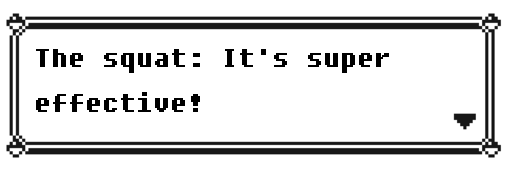
Squats are one of the most foundational functional movements in our lives. Let’s talk about the benefits and why you should be squatting all the time.
#1) We’re designed to squat: We’ve been squatting since we were babies, but as we get older and sit in unnatural positions all day, our squat form goes from perfect to terrible.
Crap.
In many countries, people often sit in a full squat for hours at a time.
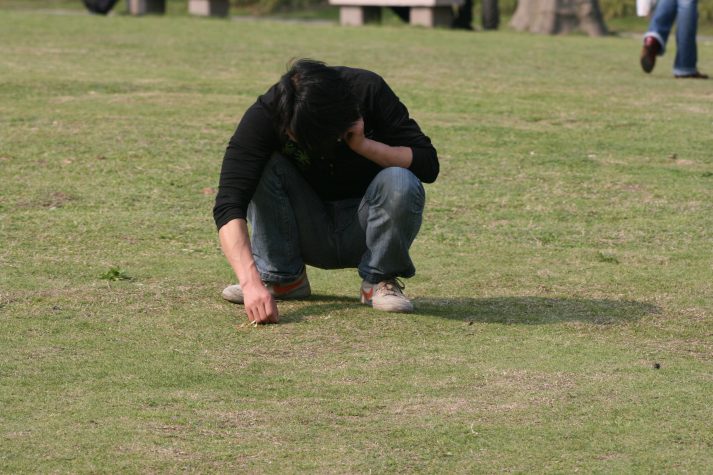
In other countries, the toilet is simply a hole in a floor, rather than a porcelain throne – over which to squat.
From an evolutionary standpoint – it makes sense that we are genetically designed – and can be really good at – squatting. Before modern day furniture and technology you didn’t stop sitting in a full squat once you got older like we do today…you continued squatting your entire life.
#2) Squats are a compound movement that recruits most of our muscles – this means it’s a movement that uses more than one joint (your hip and knee joints) to complete.
Like so:
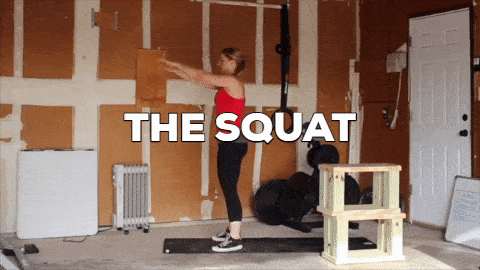
A simple bodyweight squat – which I’m demonstrating above – uses almost every muscle in the core and lower body. If you add a dumbbell or barbell into the equation, I would even argue that they use every single major muscle group to complete.
Think about it: in addition to every muscle in your “legs,” you need your hips, your back and core, your shoulders and arms. Nothing is left out with this monster movement.
Because of the utilization of a large amount of muscle groups, squats cause your body to increase our anabolic hormone production, helping us lose fat and build muscle.[1]
#3) Squats will help strengthen your bones and your muscles (and your knees!), and can also increase flexibility.
Increasing the strength in your knees and hips (and entire body) reduces your chance of injury while doing both athletic movements and everyday life things (such as shoveling the driveway or standing up and sitting down).
And by learning to squat deeply, safely, you’re improving your range of motion and helping make you antifragile and protecting yourself against future injury. Bazinga!

If your goals are to:
- Build muscle and get stronger, squats will get you there faster.
- Lose weight and get ‘toned,’ squats will get you there faster.
- Look better naked, squats will get you there faster.
- Get healthier and happier, squats will get you there faster.
- Feel like an absolute badass in the gym, squats will get you there faster.
In short, squats are amazing.
Squats also make you look amazing in shorts.
(see what I did there?)
I’m the lead female trainer at Nerd Fitness, and my life has been absolutely transformed by barbell training, which is why I’m so excited to share this guide with you.
Back in 2011, I could barely pick up a pink dumbbell, and now I regularly compete in powerlifting competitions. Here I am squatting 253lbs for 3 sets of 5 at a bodyweight of 150 pounds:
View this post on Instagram
A post shared by Staci Ardison (@staciardison) on Jun 25, 2019 at 1:47pm PDT
I am so excited to teach you how to squat today, as I’ve taught tons of coaching clients how to get started too.
Let’s start off by taking a look at the bodyweight squat – the first move you should master before you add weight.
How to Do a Bodyweight Squat With Proper Form
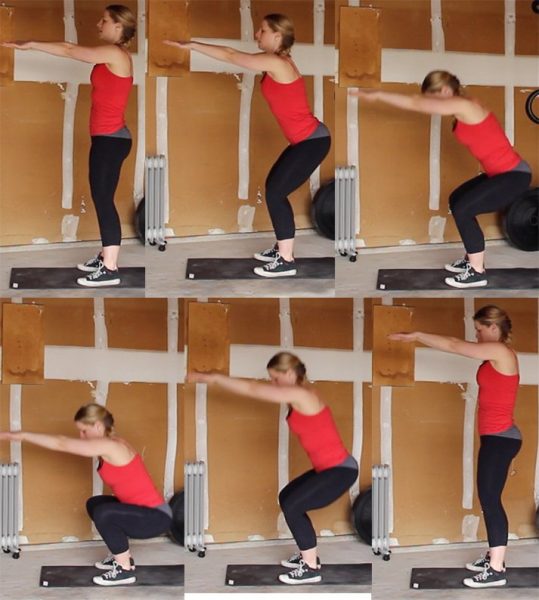
The setup for the squat exercise is incredibly simple.
- Stand with your feet slightly wider than your hips.
- Your toes should be pointed slightly outward – about 5 to 20 degrees outward.
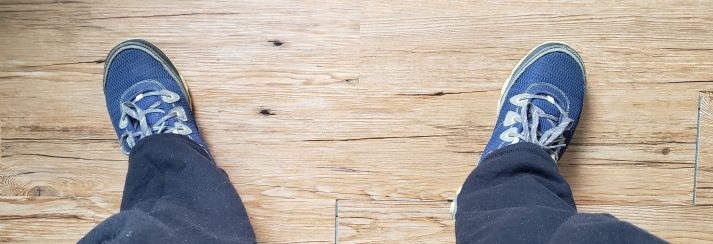
- Look straight ahead and pick a spot on the wall in front of you.
- Look at this spot the entire time you squat, not looking down at the floor or up at the ceiling.
I go over the setup and the full movement in this video:
- Put your arms straight out in front of you, parallel to the ground.
- Keep your chest up and proud, and your spine in a neutral position.
- Think about where your weight is on your feet – it should be on the heels and the balls of your feet, as if you were pasted to the ground. You should be able to wiggle your toes the entire movement (though that’s not a part of squatting!).
- Keep your entire body tight the entire time, your core flexed like you’re bracing to be punched in the gut!
- Breathe deep into your stomach, break at your hip and push your butt back. Keep sending your hips backwards as your knees begin to bend. It’s important to start with your hips back, and not by bending your knees.
- As you squat down, focus on keeping your knees in line with your feet. Many new lifters need to focus on pushing their knees out so they track with their feet. When they start to come inside the toes, push them out (but not wider than your feet). Think about it like this: if you were to attach a laser to the end of each of your knees, the laser would track between your second and fourth toes. Make sure your knees are out!
- Squat down until your hip joint is lower than your knees (what we call “parallel” in the squat game). Note: if you THINK you might not be squatting deep enough, you probably aren’t!
- So not like this:
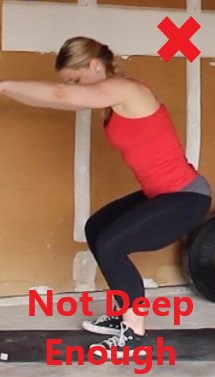
-
- But like this:
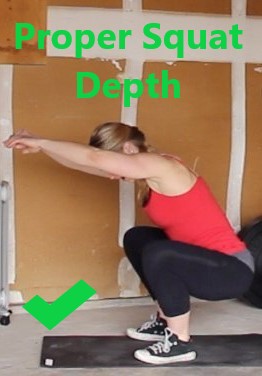
- Depending on the size of your thighs, your squat may appear to be less deep than it truly is. You can go deeper than this, however, anything less than parallel is a partial squat. That’s a power curtsy. We don’t do those at NF. We do full squats!
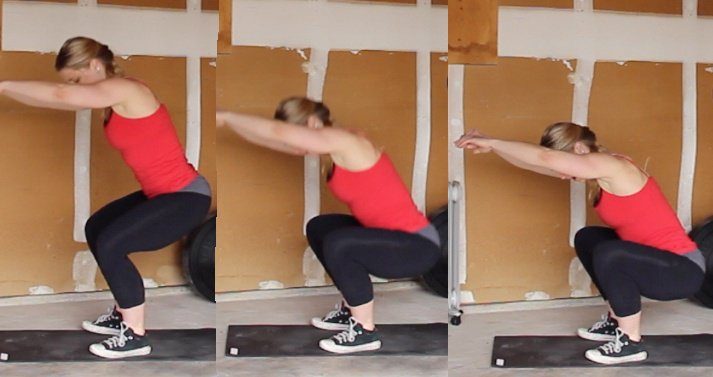
Once at the bottom, it’s time to stand back up from your squat:
- Keeping everything tight, breathe out and drive through your heels (keep the balls of your feet on the ground as well).
- Drive your knees outward (away from each other) the same way you did on the way down, and squeeze your butt at the top to make sure you’re using your glutes.
Here is a video from us nerds at Team Nerd Fitness (with instructions from Jim, lead trainer at our 1-on-1 Online Coaching Program) that will teach you good form on a bodyweight squat:
Once you can do multiple sets of 15+ deep bodyweight squats with proper form, it’s time to move onto barbell squats!
If you are unsure about being able to do squats with a 45-pound barbell, you can follow our Gym Workout Level 4 Program, which includes dumbbell goblet squats, a good stepping stone to barbell squats:
Note: Due to the fact that all of our bodies are different (you are a unique snowflake), none of our “perfect” squats will look exactly the same. Someone with a longer femur, for example, will squat slightly different than someone with a shorter femur.
Also, the majority of the population has some sort of mobility issue (including myself!) that they are working on fixing – so if your squat looks different than the person next to you, that does not mean you’re doing it wrong!
We have LOTS of 1-on-1 coaching clients who are new to squatting, and it often comes down to ankle flexibility and hip mobility. If you spend all day every day sitting in a desk chair, this might be you!
If you want us to help you fix your squat depth and start getting stronger, that’s what we’re here for!
How to Do the Barbell Back Squat, Step-By-Step
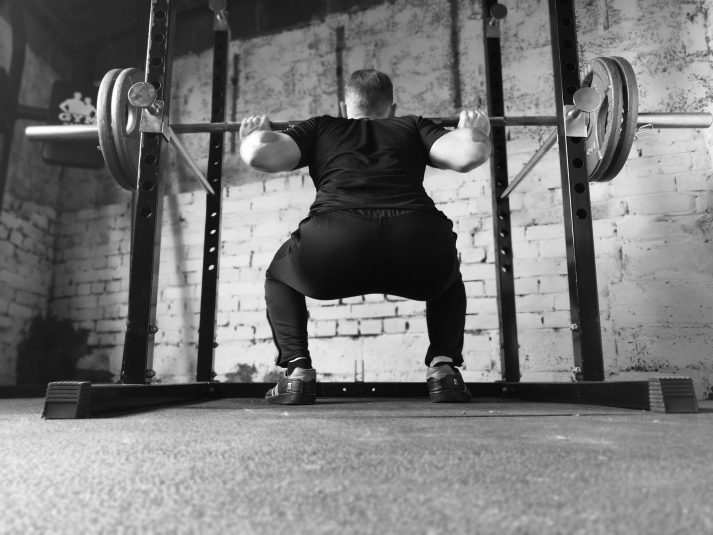
BARBELL BACK SQUAT SETUP:
#1) Find – find a squat rack, power cage, or a squat stand. It’ll look something like this, with an unattached barbell:
A. Squat Rack: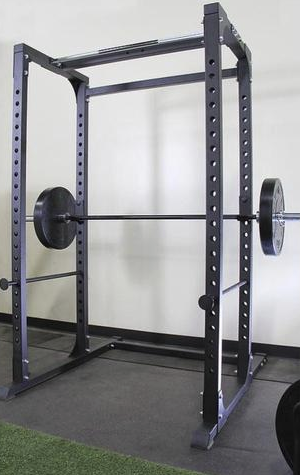
B. Power Cage: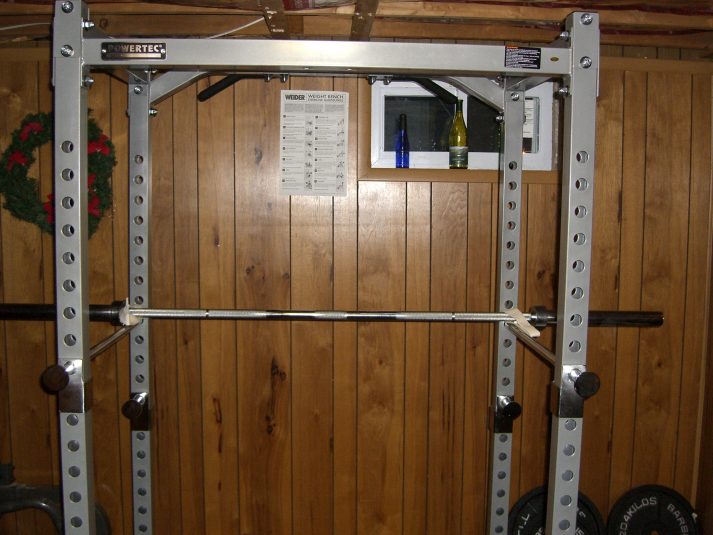
C. Squat Stand: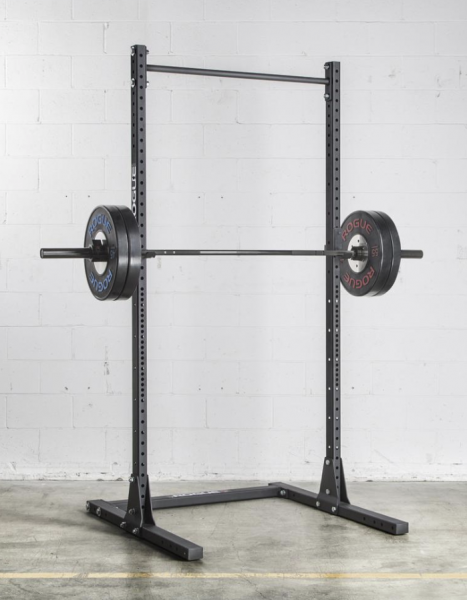
Note: this is NOT the same thing as a Smith Machine, where the barbell is attached to the machine:
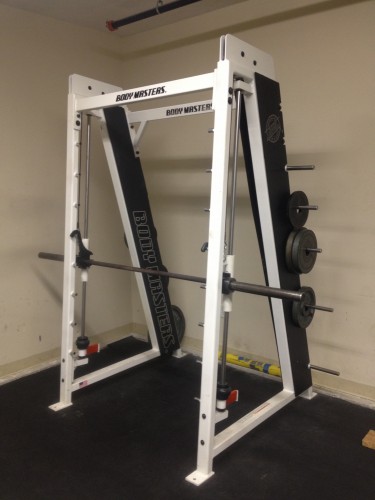
You do NOT want a Smith Machine. You need a completely unattached barbell in order to do a barbell squat properly and safely. Don’t squat in a Smith Machine.
#2) Set the height of the bar to be about the same height as your collarbone. Not sure how to set the height of the bar? I got you:
If your options are either too high or too low, it’s always best to go too low. You don’t want to have to get up on your toes to rack/unrack the bar, especially as the weight gets heavier.
#3) Decide if you are going to do a high bar squat, or a low bar squat. Either is fine, but there IS a difference:

The “Low Bar Back Squat” is the most common form done by beginners, general lifters, and powerlifters. It’s also the form taught in Starting Strength, one of the best books for beginners on the market. So we’ll be focusing on that version for the rest of this section:
#4) Always squat with just the bar to start – as we discuss in “How much weight should I be lifting,” even if you’re planning on squatting 500 lbs, always start with just the bar!
HOW TO DO A PROPER BACK SQUAT:
Facing the bar, step under it, and put your hands around it on either side of you. For this type of squat, we are going to want a thumbless grip, so that our wrists are properly aligned with our forearms.
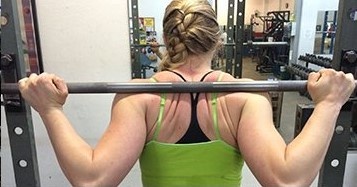
The width of your grip will be dependent on flexibility, but generally a narrower (closer to your shoulders) grip will help create a meaty shelf for you to place the bar on out of the muscles in your upper back – the bar will end up sitting on your rear deltoids (see the above image).
If you lack the flexibility for the narrower grip (which is super common), start out wider, then slowly bring it in as you get more flexible.
See the difference here between a “high bar, wrapped grip” (Left) and “low bar, thumbless grip” (right):

And now time to SQUAT!
Here is how to barbell squat:
- With the weight on your shoulders, step back from the supports
- Your feet should be slightly wider than hip-width apart
- Your toes should be slightly pointing outward
- Flex your stomach, squeeze your glutes, inhale deeply into your stomach
- Move your butt back, squat down slowly
- Continue to drop until the tops of your legs are parallel or lower (the crease of your hip is below your waist)
- Explode back up to the starting position
- After your set is complete, walk carefully forward to return the weight to the rack, and lower it down safely onto the supports
- High five yourself, you just did a barbell squat!
Not sure if you squatted deep enough? Record yourself! 95% of the people I see doing squats in a gym don’t go deep enough!
Nervous about squatting correctly? Yes, I am a mind reader, and yes we can help you!
If you want an expert to check your squat form check out our 1-on-1 Coaching program. Our coaching app lets you record and send a video of your movement directly to your coach, who will provide specific feedback and build a custom program just for you.
Interested? Click below to jump on a free call with our team to see how our online coaching program will get you the results you’re after:
How to Do a Proper Front Squat

The last version of the squat that we are going to cover in this guide is the front squat.
Due to the placement on the front of the shoulders instead of on the back, the front squat is more quad dominant (the front of your upper legs), but also requires you to be able to keep your torso much more upright than with the back squat (both versions).
How to set up for a Front Squat:
- Make sure the bar is set at the proper height (see the previous section on squat set-up!)
- Facing the bar, place the bar on the front of your shoulders.
- Grab the bar with your hands. This is the most difficult part with the front squat – it requires a lot of wrist mobility and flexibility.
Here’s a video demonstrating the barbell front squat from the Nerd Fitness Academy:
How to front squat:
- Keep your elbows high and the weight firmly in place on your shoulders.
- Flexing your stomach and squeezing your glutes, inhale deeply into your stomach.
- Move your butt backwards and begin your movement downward.
- Drop until your hip crease is below your knees (below parallel).
- Explode back upwards to your starting position.
Most people can not front squat with a full grip around the bar, and instead will let the bar roll onto their fingertips (a three finger grip is okay here).
If you can’t even get your fingers around the bar, there are a few variations you can start with until your shoulder and wrist mobility improve.
- The Genie Front Squat:
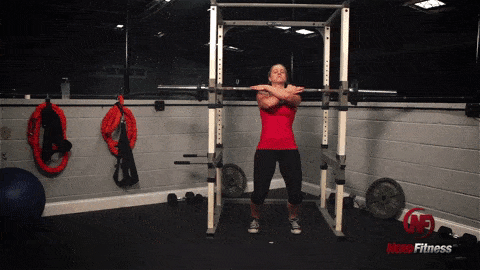
Keep your hands holding on to the bar if you can (it’s okay to let the bar roll onto your fingertips), and keep your elbows up so that your upper arms are as parallel to the floor as possible.
- The Dumbbell Front Squat:
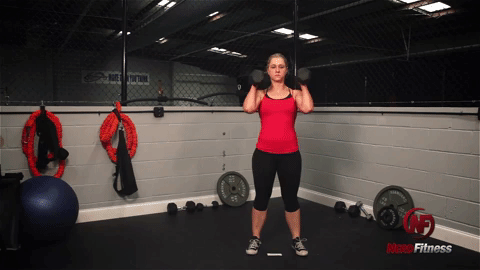
Stand slightly wider than shoulder-width apart with your toes pointed slightly outward. Raise the dumbbells to your shoulders and hold them there. Keeping your core tight and butt flexed, sit down and backward with your butt. Go down until the tops of your thighs are lower than parallel.
Once you get good at these movements, you can think about rocking the front squat:
View this post on Instagram
A post shared by Staci Ardison (@staciardison) on Feb 26, 2014 at 7:22pm PST
FRONT SQUAT TIPS:
#1) Keeping your elbows as high as possible the entire time. As soon as you let them drop, the weight will likely pull you forward out of correct positioning, and you will either drop the weight or potentially get injured.
#2) The barbell should be on the meaty parts of your shoulders, with your hands there to keep the weight in place. If you let the weight roll towards you too much, you’ll feel the barbell across your throat and might have trouble breathing. As you can guess, we want to avoid this!

Not sure if you’re front-squatting correctly? It’s a fairly technical movement that requires flexibility and mobility in all of the right places. If want an expert to not only check your form, but also help you get flexible and stronger, you’ve come to the right place!
How Do I Bail Out of a Squat Safely?
If you are going to squat, you have to know how to “fail” at squatting safely! After all, there’s nothing more scary than being stuck in the bottom of a squat movement and not knowing how to get out of there!
A squat is very different from a barbell deadlift in that aspect: if you fail on a deadlift, you just don’t pick up the weight. If you fail on a squat, you’re trapped under a bar with potentially a lot of weight on it.
This can lead to SERIOUS injury. So please, learn how to bail out of a squat safely before you start attempting to do heavy barbell squats.
This will help give you the confidence to push yourself and get stronger!
6 Common Mistakes When Doing Squats
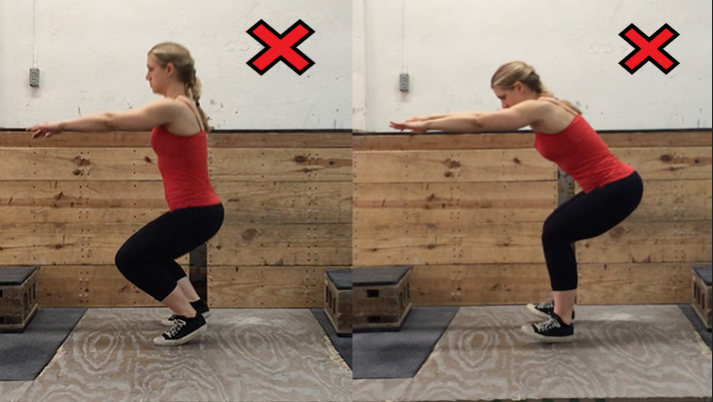
The squat is a basic movement, but those new to lifting often fall victim to a handful of common mistakes.
Let’s take a look at some of the big problems and how to fix it!
#1) Coming up on your toes with your knees forward during your squat
It’s important to keep your heels on the ground the entire time you’re squatting.
You should be driving down through your heels, and in order to do that, they need to be on the ground!
While some of your weight will be on the balls of your feet, you never want all of your weight to be on the balls of your feet or your toes.
You should be able to lift your toes up off the ground and wiggle them at any point and it shouldn’t change anything about your squat.
#2) Not hitting enough depth for your squat

Your squat should hit at least parallel – where your hip joint goes below the knee.
Depending on what you’re training for, you can go lower, but in order to maximize the muscles worked in the squat, it needs to be done to at least parallel or lower.
If you squat above parallel (a partial squat) you’re leaving the hamstrings out of the movement. This puts more pressure on the knee – the force put on your knee is actually reduced as you drop below parallel.
Unfortunately, there’s a lot of misunderstanding about squats and knee issues.
The deeper the squat, the more glutes that are activated as well. Deeper is typically harder, both strength and flexibility wise. However, depending on your goals, squatting to parallel may make more sense.
If you’re struggling hitting depth there could be many causes – you could have poor ankle mobility, tight hip flexors and/or hamstrings, weak glutes, or poor pelvic alignment (among many other things).
This is something we work closely with our coaching clients on, and often prescribe ankle and hip mobility drills to help clients reach proper depth on squats!
#3) Knee Positioning
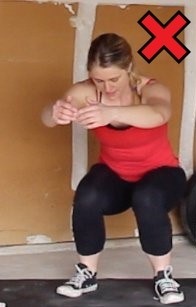
When you squat, you want your knees to track along with your toes. This means if you are looking down at your knees and feet, your knees should be aligned at the same angle as your feet throughout the movement.
Everyone’s exact positioning is going to be slightly different, but they should not be on the outside or the inside of the foot.
#4) Back Positioning
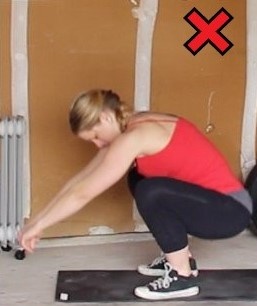
Your chest should be up and shoulders should be back, like you’re King Kong about to pound your chest proudly. Your body should stay in this position the entire time. You don’t want your shoulders to round forward, but you also don’t want to hyperextend your back either.
Keeping your spine in a neutral position will help your spine safe and build a strong foundation throughout the heavy squat movement.
#5) Head Positioning
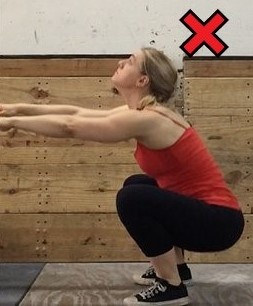
Many coaches will tell their lifters to look up, as that is the direction in which you want to be moving, but this is actually the last thing you want to do. Take a second quick and look at the ceiling (I’ll wait!  ).
).
Now, see that position your neck vertebrae are in? That is a very unsafe position for your spine to be in, especially when weight starts getting included in the equation. You also don’t want to be looking directly at the floor.
Look straight out in front of you the entire time, with your head in a “neutral” position. Your chin should be in a position where you could hold a tennis ball between your chest and your chin.
#6) Too much weight on the heels/on the outside or inside of feet during your squat
When trying to fix coming up on your toes, or your knee positioning, it is common for people to focus so much on keeping their weight on their heels that they forget to keep the balls of their feet on the ground! Some of your weight will still be on the ball of your foot – if you are truly only having weight on your heels, it’s pretty hard to balance.
To the same effect, if the inside of your foot or the outside of your foot comes up off the floor, this is also not a good thing!
How do you know if you’re making these mistakes? Simple! Record yourself doing squats. I do. And so does anybody else who is serious about improving their squats.
Often we look VERY different than we think we look when doing an exercise, so having a video of the movement is often the only way we can improve.
If you can’t self-diagnose your squat challenges, let us help!
Squat Variations for Beginners: The Box Squat
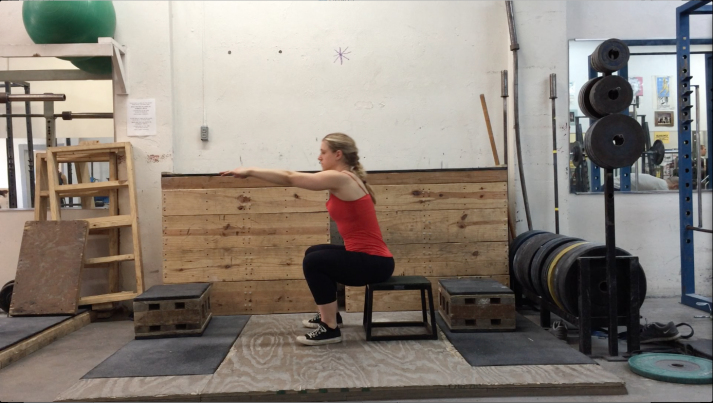
In this section, we’re going to go over some squat variations to help you improve your form and build confidence before hitting the free weights section of the gym.
If you’re struggling to do a squat correctly, don’t fret!
I’m going to teach you about…
BOX SQUATS!
Squatting to a box will help teach you to sit back and keep your weight on your entire foot, instead of squatting with your knees forward and up on your toes.
Squatting back to a box is also great for people who have bad knees and can’t do bodyweight squats anymore.
You can do box squats with a barbell as well, but for this explanation, we’re just going to keep it simple with bodyweight box squats.
In order to do this, find a box or a chair that is the right height so when you sit on it, you are at parallel with your squat. Your options include things like step stools, milk crates, or the smallest box at the gym (there’s usually a set of plyo boxes, and the shortest is around 10″.)
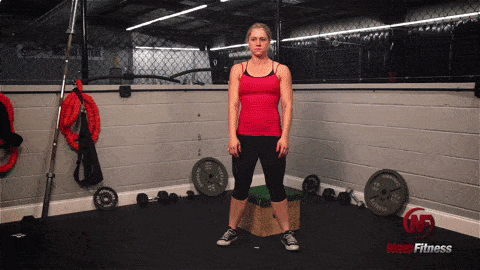
The lower the box, the more it will help you develop stronger hips and low back – the box at exactly parallel will help you more with quad strength.
Set up exactly as if you were going to do a regular bodyweight squat, only standing about a foot in front of the box.
- Breathe in deeply, brace your core, move butt back, and keep your knees in line tracking in the same direction as your toes and squat back until you sit completely on the box. Don’t plop back on the box, make it slow and deliberate while keeping your entire body tight.
- Now, don’t move! Think about your positioning. Are your back and core still super tight? Is your weight on your heels and your mid foot? Is your head in a neutral position? Great, now stand up by driving your hips upward, don’t let your weight shift forward and onto your toes (drive through your heels!), shoulders and chest up, knees out keeping them lined up with your toes.
For your first few, feel free to sit on the box while you evaluate your positioning, but as you get better at them, sit back and then quickly stand up again.
You know you’re doing a good squat when you can stand back up from the bottom of a squat position without having to lean forward and use momentum to get up.
You can squat, touch your butt to the box, and then stand back up without having to shift your weight around! KEEP THAT BUTT BACK!
I know all of this can be overwhelming, so the important thing is that you START! I realize I sound like a broken record at this point, but I really want you to begin strength training today. We created our free guide, Strength Training 101: Everything You Need to Know, just for that purpose. I’d love to send it to you, because I know it’ll help you overcome any fears and confusion and have you getting stronger TODAY
Get it when you sign up in this box below – I’m excited to hear what you think of it!
- Everything you need to know about getting strong.
- Workout routines for bodyweight AND weight training.
- How to find the right gym and train properly in one.
Woman
Man
How to Start Squatting Like A Pro

Squats are awesome.
How awesome? This kid dropped into a perfect squat just to impress his bunny friend.
And if you want to learn more about squats, or you’re looking to build more confidence before you get started, we have a few options for you:
1) If you are somebody that wants to follow a tailor-made program that designed around their life and goals, check out our popular 1-on-1 Online Coaching Program.
You’ll work with our certified NF instructors who will get to know you better than you know yourself, check your form, and program your workouts and nutrition for you.
2) Good at following instructions and want a blueprint to follow? Check out our self-paced online course, the Nerd Fitness Academy.
20+ workouts for both bodyweight or weight training, a benchmark test to determine your starting workout, HD demonstrations of every movement, boss battles, nutritional leveling system, a questing system, and supportive community.
3) Download our free Strength 101 Guide, which you can get when you sign up in the box below:
- Everything you need to know about getting strong.
- Workout routines for bodyweight AND weight training.
- How to find the right gym and train properly in one.
Woman
Man
And I’d love to hear from you! PLEASE leave your questions, squat or fitness or otherwise below so we can answer them and become best friends:
What struggles do you have when trying to squat?
What questions do you have?
If you haven’t squatted before, what else do you need us to tell you to give you the confidence to start squatting TODAY!?
-Staci
PS: Be sure to check out the rest of the Strength Training 101 series:
- Strength Training 101: How to Get Strong
- How to Find the Right Gym
- 6 Beginner Gym Workouts: A Beginners Guide to the Gym
- Beginner Strength Workouts
- How Much Weight Should I Be lifting?
- Strength Training 101: Inverted Rows
- Strength Training 101: The Bench Press
- Strength Training 101: The Overhead Press
- Strength Training 101: The Deadlift
PPS: I typed this whole article while sitting in a squat. Okay, no I didn’t, but that would have been cool.
###
photo source: Barbell Squat, Jordan Colley Visuals: bunny squat, power rack, squat stand, squat rack,
- Check out this study on squats and anabolic hormone production.
Filed under: Fitness

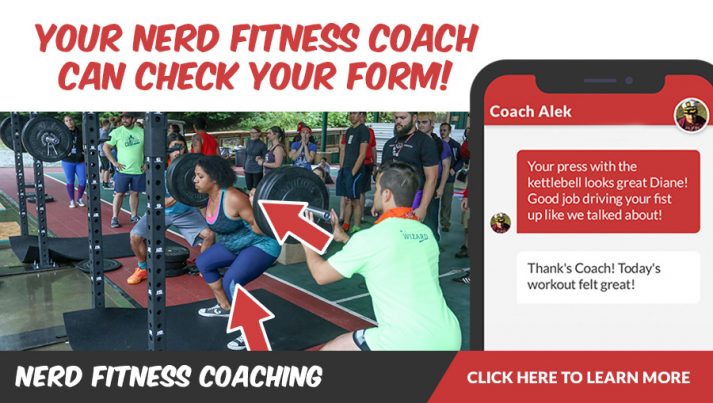
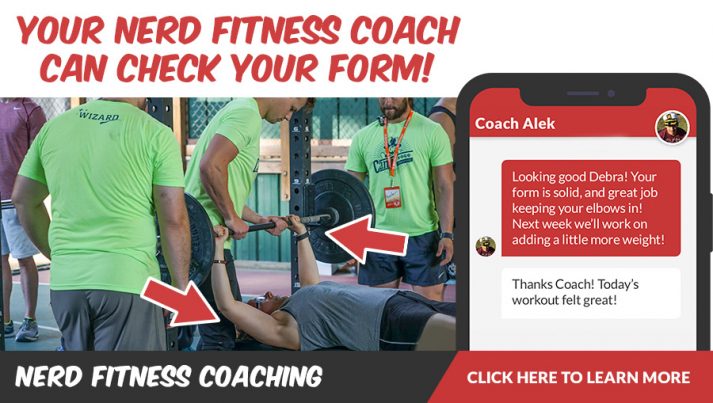
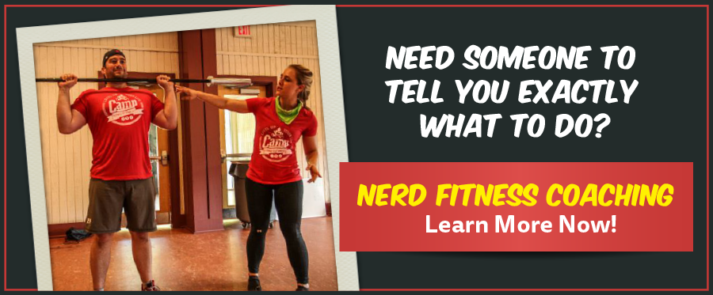
 For now classes are 6pm and 640pm at 2840 Wildwood st in the Boise Cloggers studio.
Book your class NOW!
click this ==>
For now classes are 6pm and 640pm at 2840 Wildwood st in the Boise Cloggers studio.
Book your class NOW!
click this ==>








